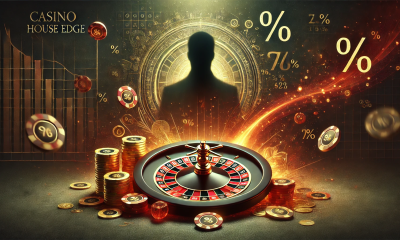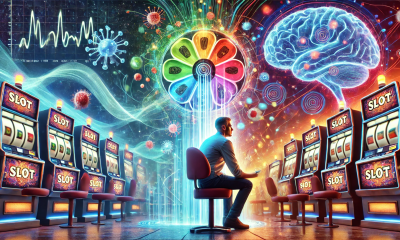Science
Randomness and Slot Machines: How Algorithms Determine Payouts

On the face of it, slots are the easiest games to play and even the most complex titles can be mastered within a few rounds of gameplay. They are by far the most highly demanded games at any casino – online or otherwise. Whether you stop by a gas station slots arcade, enter a renowned casino on the Vegas Strip, or open an online casino games lobby, the majority of the games will be slots.
The premise of the games are always the same. You have a grid of reels that you can spin, and if you land a combination of matching symbols, you can win some money. But this simple concept has taken on all sorts of manifestations, with the implementation of different slots mechanics, bonus games, extras and features that bring the games to life. Unlike other card based games, dice or roulette, there are far more outcomes and possibilities. Behind the machine lies a powerful engine that uses complex algorithms to randomize the outcome of each spin, and these are calibrated to ensure the games are fully fair to play.
But how do we know they are, and can we calculate the probability of winning playing slots?
How Slots Algorithms Work
The primary engine of a slot machine powers a random number generator to determine the outcome of every spin. This means that the outcome is not affected by any kinds of external factors. The time of the day, how much money you have spent, previous outcomes, and the size of your stake do not influence the RNG at all. They calculate thousands of outcomes in a matter of seconds, finally landing on one sequence at the end of each game. The RNG does not stop after the round is finished. These engines run continuously even in the time between your spins.
This all ensures that the outcomes are random every single time you spin. But that is not the end of it. Independent auditors and game developers must thoroughly test online and physical slot machines. During testing, the machines form hundreds of thousands of spins in a short time, and these outcomes are used to calculate two values. The Return to Player (RTP) and the Volatility.
Both these values can only be assigned after both the developers and independent game auditors have finished their testing.
Fun fact: One video slot may have a different RTP at different online casinos. This is because online casinos can calibrate the games, alter the paytables and tweak the games to their liking. For example, a slot may have an RTP of 96.1% at one casino and 96.4% at another.
Defining RTP
RTP is the theoretical value at which a video slot will pay out. It is a value under 100%, and basically the higher the value is, the better it performs under laboratory results. In theory, it means that if you spend $100 on a 96.5% RTP slot for a long period of time, you should have around $96.5 left. Slots never have over 100% because this would imply that the game does not make any money for the casino. But RTP is just a theoretical number. It does not mean that you will necessarily get $96.50 after spending $100.
- Low Slots RTP: 85% – 92.99%
- Medium Slots RTP: 93% – 96.99%
- High Slots RTP: 97% and up
After reviewing countless video slots at different online casinos, our experts have come up with the above numbers. Slots around the 94% range are quite average in terms of RTP, but the few games with an RTP of over 97% are the ones that theoretically pay out the most.

Volatility in Slots
This range has nothing to do with RTP, but instead refers to how the slot is most likely to payout. High volatility means that you are less likely to win each round, but when you do then the wins are bigger. In low volatility slots, the wins will come more often but they will not be as large at the high volatility slots.
Again, this range is theoretical and doesn’t mean you will not win big on either. It is a matter of preference, and in some cases, your budget.
Most slots players with smaller budgets go for low volatility games, as they can win smaller sums more often and extend their gameplay. Slots players with bigger budgets may be less concerned about losing 5 times in a row, as they are waiting to trigger a big bonus round or land a high value payline.
However, there are no budget restrictions at all. A player with a low budget can still stake penny rounds on a high volatility game. It is more about preference. You can decide whether you want to win more often or value the bigger wins, but less frequently.

How Paylines Work
In the original slot mechanics, you would get rewarded for landing a sequence of matching symbols across a payline. These classic slots have a handful of fixed paylines, and you will only win if you can cover the lines from left to right with a sequence of matching symbols.

Some modern games have the same fixed payline mechanics, but may offer players the chance to increase or reduce the paylines. You have a starting stake, and for each additional payline that you want to include, you have to multiply your original stake. For example, if I play 10 cents on each line and only have 4, then a spin would cost only 50 cents. But if I want to max out the 20 lines that it offers, then I will need to stake a dollar for every spin. Gamers are encouraged to max out these values, as in some cases, it can change the RTP.
Base Game Additional Features
Mechanics are a playful way developers can make their games stand out from the crowd. The traditional slots have 3 or 5 reels, 15-20 fixed paylines, and require 3+ matching symbols in a sequence to unlock a payout. Games can have bigger grids with even 8 or more reels, more paylines or Ways Pays mechanics, and sometimes only require 2+ matching symbols to win a partial payout.
There are also Megaways mechanics in which the number of reels changes with each spin, cascading reels, and even multi-directional paylines. They can mix things up with special symbols. Wilds are symbols that can be substituted for any other symbol to form a winning sequence. Some slots have cashpot symbols, that unlock an instant cash prize if you land 3 or more. Then, there are scatter symbols that can trigger bonus rounds.
How Bonus Rounds Work
The base gameplay involves you spinning the reels, and staking money for every game. But if you trigger a bonus round, you are taken out of the base game and start a bonus game. You can’t stake money during the bonus game. It runs for a limited number of spins or rounds, and you collect all the money made at the end.
The most common bonus game is another slots game. You get a set number of respins, and the bonus game may include wilds, scatters (to extend the bonus game), and even cashpot symbols. A lot of slots have expanding or sticky wilds in their bonus games to make them even more profitable. They can also have scatters to extend the bonus round, effectively giving you the chance to amplify your winnings. They can even use increasing multipliers to take the winnings to another level.
But sometimes the bonus games do not involve reels or spinning. Some games have bonus picking games. For example picking a card from a deck, or a treasure chest, which will unlock a prize. To top it off, bonus games sometimes have a gamble feature at the end. This gives you the chance to play double or nothing with the money you won from the bonus game.
Fun fact: Gamble features also use RNGs. This is called a secondary decision, and international gambling regulations have criminalized predetermined gamble options. The result of whether you win or lose cannot already be determined at the time you are offered the gamble option.
Calculating Slots Probability
Calculating the RTP is all the more difficult with all the advanced mechanics, special symbols and bonus rounds. Forming partial payouts, such as only landing 2 or 3 matching symbols in a sequence may pay out less than your stake. Take a game with 10 symbols, where each symbol has 3 possible payouts (3, 4 or 5 matching symbols), and the most valuable symbol has 4 (2, 3, 4, or 5 matching symbols).

This means, there are a total of 31 different possible payouts in the base game. Though there is every chance you can land none or even multiple winning combinations. We haven’t even factored in the different paylines either.
But let’s look at the possibility of landing a 5-symbol sequence for each of the 10 numbers. If we are going on the odds implied by the paytables, we get the following (from the example above).
- Fishing Bait: $200 payout = 0.5% Probability
- Fishing Rod: $100 payout = 1% Probability
- Dragonfly/Box: $50 payout = 2% Probability
- Caught Fish: $20 payout = 5% Probability
- A/K/Q/J/10: $10 payout = 10% Probability
But we have not factored in the RTP of the game. If the RTP is set at a good value of 95%, the probability would drop to the following:
- Fishing Bait: $200 payout = 0.475% Probability
- Fishing Rod: $100 payout = 0.95% Probability
- Dragonfly/Box: $50 payout = 1.9% Probability
- Caught Fish: $20 payout = 4.75% Probability
- A/K/Q/J/10: $10 payout = 9.5% Probability
The logic would be that after 100 spins of $1 each, you would win $95, but RTP does not work that way. Those tests were done under hundreds of thousands of simulations. Random Number Generators do not factor in the previous results, nor how much you stake and how much you have already spent playing.
How Algorithms Affect Your Gaming
It all boils down to fair play, as is the case with every other casino game on the market. RNGs in slots are there to ensure that the games are fully randomized and not rigged in any way. The games are not calibrated to deprive you of winning. Nor are they specially crafted to bring you near misses, to try to get you hooked.
Licensed online casino operators must work with approved game labs that ensure that the games are fair to play. They cannot put their own calculations onto the games. As then there are no assurances that they are really fair to play. Online casinos need the seal of approval from a renowned auditor. Here are some of the most respected game testing labs.
If any of these, or similar auditors, then you know the games use RNGs and are safe to play.













